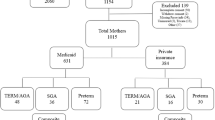Objectives: To determine the proportion of infants who are uninsured and the sociodemographic characteristics of their mothers, including prenatal and post-partum insurance coverage, in order to identify strategies to increase infant health coverage. Methods: Data from the 2001 California Maternal and Infant Health Assessment (MIHA) were analyzed. MIHA is a cross-sectional survey of a statewide representative sample of 3,475 postpartum women. We calculated the proportion of uninsured infants overall and by several maternal characteristics. Adjusted and unadjusted odds ratios for infant uninsurance are reported. Results: In the overall study sample, 8.7% of infants were uninsured. Low-income infants were significantly more likely to be uninsured than infants in households with incomes above 200% of the federal poverty level (13.7% vs. 2.5%). The mother's prenatal and post-partum health coverage, her age, and family income were associated with an increased risk of infant uninsurance after adjustment for other maternal characteristics. A large majority of the uninsured infants (88.1%) were living in low-income families. The mothers of 60% of the uninsured infants were enrolled in Medicaid during the pregnancy. Conclusions: Approximately 14% of California's low-income infants were uninsured at the time of the survey despite being income-eligible for Medicaid. The proportion of uninsured infants could potentially be reduced by more than one-half through strategies to provide 12 month continuous enrollment of infants with federally mandated Medicaid eligibility for the first year of life.
Similar content being viewed by others
References
Health Coverage for Low-Income Children. Kaiser Commission on Medicaid and the Uninsured. Kaiser Family Foundation, Menlo Park, California, May 2002.
Centers for Medicare and Medicaid: http://www.cms.hhs.gov/ researchers/pubs/datacompendium/2002/ and http://www. cms.hhs.gov/researchers/reports/2003/ellwood.pdf. Accessed December 21, 2004.
Committee on practice and ambulatory medicine recommendations for preventive pediatric health care. Pediatrics 2000;105(3):645–6.
Institute of Medicine. Health Insurance is a Family Matter, September, 2002. United States General Accounting Office. Prenatal Care: Medicaid Recipients and Uninsured Women Obtain Insufficient Care. Report to the Chairman, Subcommittee on Human Resources and Intergovernmental Relations Committee on Government Operations, House of Representatives, U.S.G.A.O., September 1987.
Brown SS, editor. Prenatal care: Reaching mothers, reaching infants. Washington, DC: National Academy Press, 1988.
Goldenberg RL, Patterson ET, Freese MP. Maternal demographic, situational and psychosocial factors and their relationship to enrollment in prenatal care: A review of the literature. Women Health 1992;19:133–51.
Perez-Woods RC. Barriers to the use of prenatal care: Critical analysis of the literature 1966–1987. J Perinatol 1990;10(4):420–34.
Braveman P, Bennett T, Lewis C, Egerter S, Showstack J. Access to prenatal care following major Medicaid eligibility expansions. JAMA 1993;269:1285–9.
California Policy Research Center Brief. Children in Immigrant Families: Issues for California's Future. CPRC Brief, 12(5), August 2000. California Program on Access to Care, California Policy Research Center, Berkeley, CA.
Dubay L, Kenney G. Covering parents through Medicaid and SCHIP: Potential benefits to low-income parents and children, Kaiser Family Foundation, 2001.
Ku L, Boraddus M. The importance of family-based insurance expansions: New research findings about state health reforms. Center on Budget and Policy Priorities, 2000.
Davidoff, Kenney G, Dubay L, Yemane A. Patterns of child–parent insurance coverage: Implications for coverage expansions. Washington, DC: Urban Institute, November, 2001.
Braveman P, et al. Promoting access to prenatal care: Lessons from the California experience. Kaiser Family Foundation, Spring, 2003.
California Department of Health Services, Maternal and Child Health Branch, personal communication, January 2005.
Title 42 of the Code of Federal Medicaid Regulations, Section 1396e(1) (4).
Strategies for improving the Medi-Cal newborn enrollment process, Newborn Enrollment Project of Maternal and Child Health Access Stakeholder Meeting, April 2002, Los Angeles, California.
Perry M, Kannel S, Burciaga Valdez R, Change C. Medicaid and children overcoming barriers to enrollment findings from a national survey. The Kaiser Commission on Medicaid and the Uninsured, January 2000.
Kenney G, Haley J. Why aren't more children enrolled in Medicaid and SCHIP? Washington, DC: Urban Institute, May 2001.
Cahow E. Analysis of eligibility loss at recertification, neighborhood health plan of Rhode Island, February 2001.
Ku L, Nimalendram S. Losing out: States are cutting 1.2 to 1.6 million low-income people from Medicaid, SCHIP and Other State Health Insurance Programs. Washington, DC: Center on Budget and Policy Priorities, December 2003.
Maternal and child health access letter to Director of the State Department of Health Services, July 22, 2002 (personal communication).
California Health Interview Survey: http://www.chis.ucla.edu/ main/DQ2/output.asp. Accessed December 21, 2004.
Braveman P, Pearl M, Egerter S, Marchi K, Williams R. Validity of insurance information on California birth certificates, Am J Public Health 1998;88(5):813–6.
Irvin C, Peikes D, Trenholm C, Kahn N. Discontinuous coverage in Medicaid and the implications for 12-month continuous coverage for children. Cambridge, MA: Mathematica Policy Research, October 2001.
ACKNOWLEDGMENTS
The authors thank Dr. Paula Braveman, Kristen Marchi, and Aimee Afable-Munsoz of the University of California, San Francisco for their thoughtful review of earlier drafts, providing background information on the Maternal and Infant Health Survey, and assistance with statistical analyses. They also thank Lucy Quacinella for access to and supporting information on the insights of California's child health advocates.
Author information
Authors and Affiliations
Corresponding author
Rights and permissions
About this article
Cite this article
Sarnoff, R., Hughes, D. Increasing Health Insurance Coverage in the First Year of Life. Matern Child Health J 9, 343–350 (2005). https://doi.org/10.1007/s10995-005-0023-5
Published:
Issue Date:
DOI: https://doi.org/10.1007/s10995-005-0023-5




